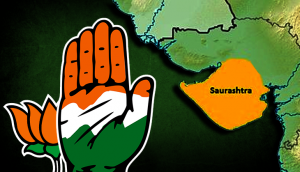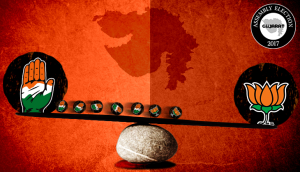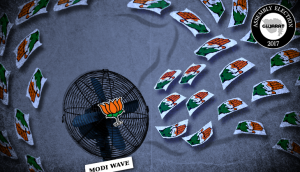
Things seem to be coming a full circle in poll-bound Gujarat. And to make matters worse for the Bharatiya Janata Party (BJP) it is the former chief minister and Patidar patriarch Keshubhai Patel who has come back to dominate the political narrative, particularly in the politically and economic affluent community of Patels.
Observers say that despite the best efforts of various forces within the BJP owing allegiance to the present Prime Minister Narendra Modi, Keshubhai could not be relegated to the oblivion in the last two decades. He has come back to politically haunt the BJP narratives at various intervals but this time his place in the political narrative is very significant with a large section of the community having alienated the BJP to support the Congress.
In fact, Hardik Patel who has emerged a youth icon among the Patels has started talking about Keshubhai at length in his rallies, much to the discomfort of the BJP leaders who can no longer be the claimants of inheriting his political legacy.
“Keshubapa was the true Patel leader who worked for the farming community. He was the one who understood their problems,” he said at his mammoth rally in Poona area of Surat on late Sunday night.
He underlined that had Keshubhai continued in power, the Kalpasar scheme would have been completed and water would have reached the parched areas of Amreli, Bhavnagar and other parts of Saurashtra. This would have prevented the farmers from these areas to migrate to other places like Surat to look for jobs and livelihood.
Kalpasar was the flagship programme of Keshubhai regime that aims at the creation of a freshwater reservoir in the Gulf of Khambhat that will store the waters of Sabarmati, Mahi, Dhadhar and Narmada along with those in Saurashtra that flow into the gulf. This water is to be used be used for irrigation, water supply and industrial requirements in the Saurashtra region.
The project also aims at reclaiming the land that has fallen prey to salinity ingress and also developing the fisheries. It was originally scheduled to be completed by 2020 but the government has been coming under criticism from various quarters for the slow pace on one side and Modi announcing schemes like SAUNI (Saurashtra Narmada Avtaran Irrigation Yojana) on the other which is dubbed by critics as 'old wine in new bottle' and many questioning its feasibility.
Hardik has also been pointing out how it was Keshubhai who had done away with a regressive land law that prevented farmers from purchasing land outside 8 km of their place of habitation. He has been saying that it is because of repealing of that law that the Patels have been able to venture out and get into vocations like real estate to become prosperous.
The legacy
Keshubhai continues to be discussed by the people in the state. The Patels see him as the tallest figure among the community after Sardar Patel. They see him as the one who made them politically and economically powerful while bringing them out of the shadow of terror of other communities.
Observers say that even when he was dislodged by Shankersinh Vaghela after the famous rebellion in the BJP ranks in 1995, it was because of Modi doing backseat driving in Keshubhai's government.
But Keshubhai had managed to bounce back in 1997 with a thumping majority. He was removed in 2001 after the government was criticised for the post-Bhuj earthquake relief efforts and the BJP lost some key local body polls and by-polls. He did not contest the 2002 Assembly polls and was sent to the Rajya Sabha was seen as his being sidelined.
Modi faced a dissident movement of sorts in 2005 over the issue of the treatment that was being meted out to the patriarch. But this dissidence was quelled and from thereon Modi became the supreme leader of the party.
He created a furore ahead of the 2007 polls with reports quoting him of calling upon his community to vote for change. There were also reports of his not casting his own vote.
Keshubhai did not renew his BJP membership and instead resigned from the party in 2012 to launch the Gujarat Parivartan Party (GPP) ahead of the elections. He won from his Visavadar constituency against the BJP candidate Kanubhai Bhalala. The GPP could manage to win only two seats.
This reporter can recall a couple of occasions when Keshubhai as GPP member had torn into the BJP claims on farmers' issues on the floor of the house.
Keshubhai then went on to resign from the post of GPP president in January 2014 and later also the member of the state assembly due to his ill health. The GPP was later merged with the BJP in February 2014.
Now it is Hardik and Congress candidates like Dhiru Gajera who have brought back the focus on him. Gajera, a former BJP MLA now contesting as the Congress candidate from Varachha seat is known as one of the voices that had taken on Modi in 2005 over the treatment given to Keshubhai. “What Hardik is saying now is just an addition to what Dhirubhai said years ago. Keshubhai was the true Patidar leader,” said a Congress worker at Gajera's office.
Chief Minister Vijay Rupani had also gone to Keshubhai to seek his blessings a day before he filed his nomination from the Rajkot (West) seat. Observers say that this gesture from Rupani had come only after Hardik had lashed out at the BJP in one of the meetings for 'isolating the tall leader from Patidar community'.
First published: 4 December 2017, 22:08 IST


_92930_300x172.jpg)
_92878_300x172.jpg)



![BJP's Kapil Mishra recreates Shankar Mahadevan’s ‘Breathless’ song to highlight Delhi pollution [WATCH] BJP's Kapil Mishra recreates Shankar Mahadevan’s ‘Breathless’ song to highlight Delhi pollution [WATCH]](https://images.catchnews.com/upload/2022/11/03/kapil-mishra_240884_300x172.png)

![Anupam Kher shares pictures of his toned body on 67th birthday [MUST SEE] Anupam Kher shares pictures of his toned body on 67th birthday [MUST SEE]](https://images.catchnews.com/upload/2022/03/07/Anupam_kher_231145_300x172.jpg)






